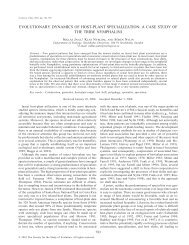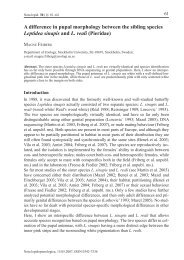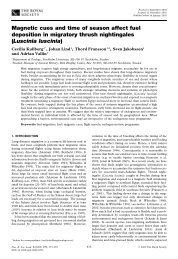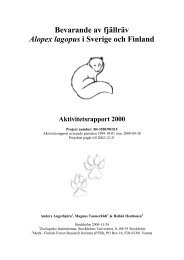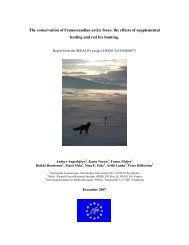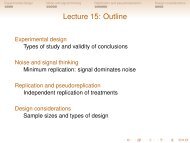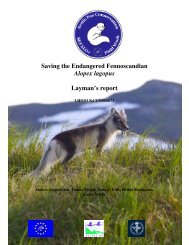Evolution of Fighting Behaviour: The Effect of Variation in Resource ...
Evolution of Fighting Behaviour: The Effect of Variation in Resource ...
Evolution of Fighting Behaviour: The Effect of Variation in Resource ...
You also want an ePaper? Increase the reach of your titles
YUMPU automatically turns print PDFs into web optimized ePapers that Google loves.
192 M. ENQUIST AND O. LEIMARopponent's subjective resource value (and choice <strong>of</strong> local strategy) from its ownsubjective resource value. In order to simplify the contest situation, we assume thatno such correlation is present. Furthermore, we assume that an <strong>in</strong>dividual can get<strong>in</strong>formation about an opponent's subjective resource value only through observation<strong>of</strong> the opponent's behaviour dur<strong>in</strong>g an <strong>in</strong>teraction. Such observation <strong>of</strong> the opponentcan result <strong>in</strong> changes <strong>in</strong> an <strong>in</strong>dividual's subjective resource value dur<strong>in</strong>g a contestby provid<strong>in</strong>g <strong>in</strong>formation about the resource. In pr<strong>in</strong>ciple, an <strong>in</strong>dividual could alsoga<strong>in</strong> <strong>in</strong>formation about the resource through direct observation <strong>of</strong> the resourcedur<strong>in</strong>g the <strong>in</strong>teraction, but we neglect this possibility.We now give a short presentation <strong>of</strong> the variables and parameters <strong>in</strong> a sequentialassessment game (for more details, see Enquist & Leimar (1983), Leimar & Enquist(1984), and Appendix C). Denote a pair <strong>of</strong> opponents by A and B, and let ca andCB be the costs per step for A and B, respectively. It is important for, say, A toestimate both these costs, and <strong>in</strong> order to reduce the number <strong>of</strong> variables that areestimated dur<strong>in</strong>g the fight, we assume that the relation CaCB = C 2 holds with the samec for all pairs <strong>of</strong> contestants (the parameter c measures how costly the mechanisms<strong>of</strong> <strong>in</strong>teraction that make up a step <strong>in</strong> the contest are). Only one variable then rema<strong>in</strong>sto be estimated by the contestants, and we choose that variable as 0 = OAa =In (CB/CA). O is referred to as the relative fight<strong>in</strong>g ability, and it has the propertythat 0as =--OBA. Prior to a fight, contestants only have limited <strong>in</strong>formation aboutthe relative fight<strong>in</strong>g ability, and this <strong>in</strong>formation can be expressed as a priordistribution, fl(O), <strong>of</strong> the relative fight<strong>in</strong>g ability (<strong>in</strong> the examples we give below,t8(0) is the same for all contestants and is symmetric around 0 =0). At each step<strong>of</strong> the fight, A assesses OaB and B assesses 0Ba. <strong>The</strong>re is some <strong>in</strong>accuracy <strong>in</strong> theseassessments, and the errors <strong>of</strong> observation for A and B are assumed to be <strong>in</strong>dependentand normally distributed with mean zero and standard deviation tr. As the fightprogresses, the contestants can get better estimates <strong>of</strong> 0 by form<strong>in</strong>g the average <strong>of</strong>ABthe observations obta<strong>in</strong>ed so far; let x, and x, be the average <strong>of</strong> the n firstobservations by A and B, respectively.We use the term local strategy to denote a contestant's decision rule given the<strong>in</strong>formation that is available prior to the contest. Of greatest <strong>in</strong>terest is prior<strong>in</strong>formation that may vary among contestants, and here we will only take <strong>in</strong>toaccount subjective resource value and, for contests with a role asymmetry, the role.A global strategy then consists <strong>of</strong> a local strategy for each subjective resource value(prior to the start <strong>of</strong> a contest) and, when appropriate, role. We only consider localstrategies where a decision whether or not to cont<strong>in</strong>ue <strong>in</strong>teract<strong>in</strong>g is based on theaverage, x,, <strong>of</strong> the so far obta<strong>in</strong>ed samples <strong>of</strong> relative fight<strong>in</strong>g ability and on thenumber, n, <strong>of</strong> samples taken. Specifically, a local strategy S is given by a level(switch<strong>in</strong>g po<strong>in</strong>t) S, for each n; if x, goes below S, the player gives up at step n.In a two-dimensional causal factor space with x and n as casual factors, A's andB's local strategies are given by switch<strong>in</strong>g l<strong>in</strong>es, and a fight can be represented asBthe random motion <strong>of</strong> A's and B's trajectories, x, a and x,, through this space. Afight ends when one <strong>of</strong> the trajectories crosses the correspond<strong>in</strong>g switch<strong>in</strong>g l<strong>in</strong>e andthat <strong>in</strong>dividual gives up (if both <strong>in</strong>dividuals cross simultaneously, one <strong>of</strong> them israndomly assigned as w<strong>in</strong>ner).



